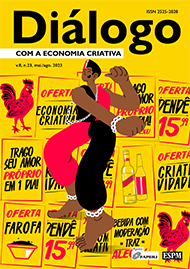Analysis of the dynamics and specialization of creative activities in Brazilian capitals and Unesco creative cities
DOI:
https://doi.org/10.22398/2525-2828.823125-149Keywords:
Creative Economy, Shift-Share, Creative CitiesAbstract
The main objective of this study is to discuss the growth of creative activities, which interface with tourism, in the 27 Brazilian capitals and in the creative cities recognized by the United Nations Educational, Scientific and Cultural Organization of Santos (state of São Paulo) and Paraty (state of Rio de Janeiro), in Brazil. To this end, a statistical application was carried out with data from the Annual Social Information Report from 2011 to 2020. To compare local potentialities in different periods, the location quotient, shift-share, and its Esteban-Marquillas formulation were used. Theresults illustrate that, as of 2017, the shrinkage rates of creative activities were higher than the shrinkage rates of conventional activities. The location quotient elucidates that there were no abrupt structural changes in terms of spatial concentration of creative activities; the shift-share emphasizes the worsening of the shrinkage of the creative economy, coinciding with the periodsof economic/institutional crises and social distancing due to the COVID-19 pandemic.
References
AGÊNCIA DE DESENVOLVIMENTO DA INDÚSTRIA CRIATIVA DE MINAS GERAIS. OBSERVATÓRIO P7 CRIATIVO. Radar economia criativa em Minas Gerais. Volume 1, 2018. Disponível em: https://fjp. mg.gov.br/wp-content/uploads/2020/07/24.8_Radar_arquivo_final.pdf. Acesso em: 8 abr. 2022.
ASHTON, M. S. G. Cidades Criativas: análise reflexiva das relações com o Turismo. In: SCHREIBER, D. (org.). Inovação e aprendizagem organizacional. Novo Hamburgo: Feevale, 2013. p. 230-245.
BILLE, T.; SCHULZE, G. Culture in urban and regional development. In: GINSBURGH, V. A.; THROSBY, D. (ed.). Handbook of the Economics of Art and Culture. Volume 1. North Holland: Elsevier, 2006. p. 1051-1099.
CWI, D. Public support of the arts: three arguments examined. Journal of Cultural Economics, v. 4, n. 2, p. 39-62, 1980.
ESTEBAN-MAQUILLAS J. M. Shift and share analysis revisited. Regional and Urban Economics, North-Holland, v. 2, n. 3, p. 249-261, 1972. https://doi.org/10.1016/0034-3331(72)90033-4
FLORIDA, R. Cities and the creative class. New York: Routledge, 2005.
GOLGHER, A. B. A distribuição de indivíduos qualificados nas regiões metropolitanas brasileiras: a influência do entretenimento e da diversidade populacional. Nova Economia, Belo Horizonte, v. 21, n. 1, p. 109-134, 2011. https://doi.org/10.1590/S0103-63512011000100004
GOLGHER, A. B. As cidades e a classe criativa no Brasil: diferenças espaciais na distribuição de indivíduos qualificados nos municípios brasileiros. Revista Brasileira de Estudos de População, Rio de Janeiro, v. 25, n. 1, p. 109-129, 2008. https://doi.org/10.1590/S0102-30982008000100007
HADDAD, P. R. (org.). Economia regional: Teorias e métodos de análise. Fortaleza: Banco do Nordeste do Brasil; ETENE, 1989.
INSTITUTO BRASILEIRO DE GEOGRAFIA E ESTATÍSTICA (IBGE). Censo Demográfico de 2000. Rio de Janeiro: IBGE, 2000.
ISARD, W. Méthodes d’analyse régionale: une introduction à la science régionale. Paris: Dunod, 1972.
LAZZERETTI, L.; BOIX, R.; CAPONE, F. Why do creative industries cluster? In: LAZZERETTI, L. (ed.). Creative Industries and Innovation in Europe: Concepts, Measures and Comparative Case Studies. Nova Iorque: Routledge, 2013. p. 45-64.
MACHADO, A. F.; SIMÕES, R. F.; DINIZ, S. C. Urban amenities and the development of creative clusters: the case of Brazil. Current Urban Studies, v. 1, n. 4, p. 92-101, 2013. https://doi.org/10.4236/cus.2013.14010
MARKUSEN, A.; GADWA, A. Arts and culture in urban or regional planning: a review and research agenda. Journal of Planning Education and Research, v. 29, n. 3, p. 379-391, 2010. https://doi.org/10.1177/0739456X09354380
MELO, G. B. V.; PAIVA, G. L. Desenvolvimento e potencial de clusters criativos para as cidades médias brasileiras. Nova Economia, v. 26, p. 1287-1316, 2016. https://doi.org/10.1590/0103-6351/3953
MINISTÉRIO DA CULTURA DO BRASIL (MINC). Plano da Secretaria da Economia Criativa: Políticas, diretrizes e ações 2011 a 2014. Brasília: Ministério da Cultura, 2011.
MINISTÉRIO DO TRABALHO E PREVIDÊNCIA. Relação Anual de Informações Sociais (RAIS). Brasília, DF, 2023. Disponível em: https://bi.mte.gov.br/bgcaged/. Acesso em: 3 maio 2023.
OBSERVATÓRIO DO TURISMO DE BELO HORIZONTE. Economia Criativa BH: Mapeamento e Análises. Belo Horizonte: BELOTUR, 2019. Disponível em: https://prefeitura.pbh.gov.br/sites/default/files/estrutura-de-governo/belotur/economia-criativa-bh-2019.pdf. Acesso em: 11 abr. 2022.
PERLOFF, H. S. Using the arts to improve life in the city. Journal of Cultural Economics, v. 3, n. 2, p. 1-21, 1979.
RIBEIRO, L. C. S. NAHAS, M. M. P. L. P.; SIMÕES, R. F.; AMARAL, P. V. M. Distribuição espacial da indústria do lazer no Brasil. Texto para Discussão, UFMG/CEDEPLAR, n. 507, 2014.
RIBEIRO, L. C. S.; LOPES, T. H. C. R. Características e similaridades do setor cultural nos municípios e regiões metropolitanas brasileiras. Revista de Economia Contemporânea, Rio de Janeiro, v. 19, n. 2, p. 307-330, 2015. https://doi.org/10.1590/198055271926
RICHARDS, G. Creativity and tourism: The state of the art. Annals of tourism research, v. 38, n. 4, p. 1225-1253, 2011. https://doi.org/10.1016/j.annals.2011.07.008
United Nations Conference on Trade and Development (UNCTAD). Creative Economy Report
Geneve & Nova York, United Nations, 2008. Disponível em: http://stats.unctad.org/Creative/tableviewer/document.aspx?FileId=125. Acesso em: 27 abr. 2023.
Downloads
Published
Issue
Section
License
Copyright (c) 2023 Jonas da Silva Henrique

This work is licensed under a Creative Commons Attribution-NonCommercial-NoDerivatives 4.0 International License.
The copyright for articles published in this journal belongs to the author, with first publication rights to the journal.
We emphasize that the responsibility for the articles is exclusive to the author(s) and does not necessarily reflect the opinion of the Editors or ESPM.











